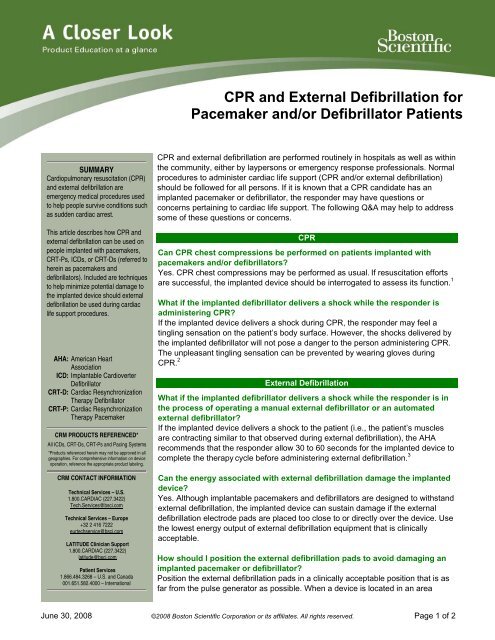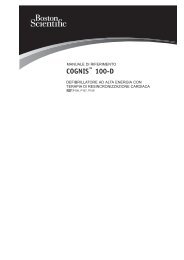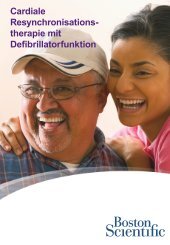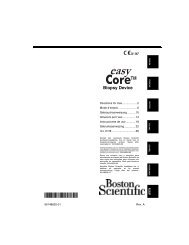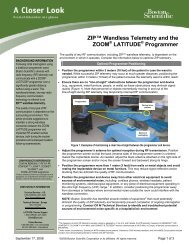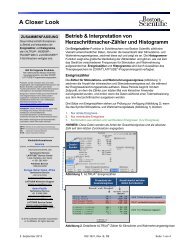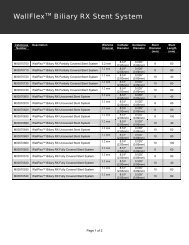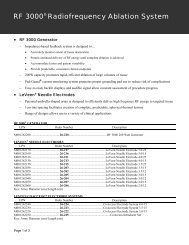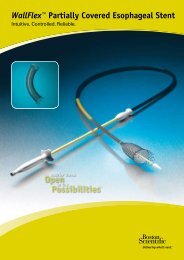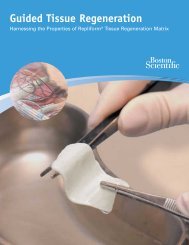CPR and External Defibrillation for Pacemaker ... - Boston Scientific
CPR and External Defibrillation for Pacemaker ... - Boston Scientific
CPR and External Defibrillation for Pacemaker ... - Boston Scientific
Create successful ePaper yourself
Turn your PDF publications into a flip-book with our unique Google optimized e-Paper software.
<strong>CPR</strong> <strong>and</strong> <strong>External</strong> <strong>Defibrillation</strong> <strong>for</strong><br />
<strong>Pacemaker</strong> <strong>and</strong>/or Defibrillator Patients<br />
SUMMARY<br />
Cardiopulmonary resuscitation (<strong>CPR</strong>)<br />
<strong>and</strong> external defibrillation are<br />
emergency medical procedures used<br />
to help people survive conditions such<br />
as sudden cardiac arrest.<br />
This article describes how <strong>CPR</strong> <strong>and</strong><br />
external defibrillation can be used on<br />
people implanted with pacemakers,<br />
CRT-Ps, ICDs, or CRT-Ds (referred to<br />
herein as pacemakers <strong>and</strong><br />
defibrillators). Included are techniques<br />
to help minimize potential damage to<br />
the implanted device should external<br />
defibrillation be used during cardiac<br />
life support procedures.<br />
AHA: American Heart<br />
Association<br />
ICD: Implantable Cardioverter<br />
Defibrillator<br />
CRT-D: Cardiac Resynchronization<br />
Therapy Defibrillator<br />
CRT-P: Cardiac Resynchronization<br />
Therapy <strong>Pacemaker</strong><br />
CRM PRODUCTS REFERENCED*<br />
All ICDs, CRT-Ds, CRT-Ps <strong>and</strong> Pacing Systems<br />
*Products referenced herein may not be approved in all<br />
geographies. For comprehensive in<strong>for</strong>mation on device<br />
operation, reference the appropriate product labeling.<br />
CRM CONTACT INFORMATION<br />
Technical Services – U.S.<br />
1.800.CARDIAC (227.3422)<br />
Tech.Services@bsci.com<br />
Technical Services – Europe<br />
+32 2 416 7222<br />
eurtechservice@bsci.com<br />
LATITUDE Clinician Support<br />
1.800.CARDIAC (227.3422)<br />
latitude@bsci.com<br />
Patient Services<br />
1.866.484.3268 – U.S. <strong>and</strong> Canada<br />
001.651.582.4000 – International<br />
<strong>CPR</strong> <strong>and</strong> external defibrillation are per<strong>for</strong>med routinely in hospitals as well as within<br />
the community, either by laypersons or emergency response professionals. Normal<br />
procedures to administer cardiac life support (<strong>CPR</strong> <strong>and</strong>/or external defibrillation)<br />
should be followed <strong>for</strong> all persons. If it is known that a <strong>CPR</strong> c<strong>and</strong>idate has an<br />
implanted pacemaker or defibrillator, the responder may have questions or<br />
concerns pertaining to cardiac life support. The following Q&A may help to address<br />
some of these questions or concerns.<br />
<strong>CPR</strong><br />
Can <strong>CPR</strong> chest compressions be per<strong>for</strong>med on patients implanted with<br />
pacemakers <strong>and</strong>/or defibrillators?<br />
Yes. <strong>CPR</strong> chest compressions may be per<strong>for</strong>med as usual. If resuscitation ef<strong>for</strong>ts<br />
are successful, the implanted device should be interrogated to assess its function. 1<br />
What if the implanted defibrillator delivers a shock while the responder is<br />
administering <strong>CPR</strong>?<br />
If the implanted device delivers a shock during <strong>CPR</strong>, the responder may feel a<br />
tingling sensation on the patient’s body surface. However, the shocks delivered by<br />
the implanted defibrillator will not pose a danger to the person administering <strong>CPR</strong>.<br />
The unpleasant tingling sensation can be prevented by wearing gloves during<br />
<strong>CPR</strong>. 2<br />
<strong>External</strong> <strong>Defibrillation</strong><br />
What if the implanted defibrillator delivers a shock while the responder is in<br />
the process of operating a manual external defibrillator or an automated<br />
external defibrillator?<br />
If the implanted device delivers a shock to the patient (i.e., the patient’s muscles<br />
are contracting similar to that observed during external defibrillation), the AHA<br />
recommends that the responder allow 30 to 60 seconds <strong>for</strong> the implanted device to<br />
complete the therapy cycle be<strong>for</strong>e administering external defibrillation. 3<br />
Can the energy associated with external defibrillation damage the implanted<br />
device?<br />
Yes. Although implantable pacemakers <strong>and</strong> defibrillators are designed to withst<strong>and</strong><br />
external defibrillation, the implanted device can sustain damage if the external<br />
defibrillation electrode pads are placed too close to or directly over the device. Use<br />
the lowest energy output of external defibrillation equipment that is clinically<br />
acceptable.<br />
How should I position the external defibrillation pads to avoid damaging an<br />
implanted pacemaker or defibrillator?<br />
Position the external defibrillation pads in a clinically acceptable position that is as<br />
far from the pulse generator as possible. When a device is located in an area<br />
June 30, 2008 ©2008 <strong>Boston</strong> <strong>Scientific</strong> Corporation or its affiliates. All rights reserved. Page 1 of 2
where a pad would normally be placed, the AHA recommends positioning the external defibrillation pad at least 1 inch<br />
(2.5 cm) away from the device. 3 Whenever possible, external defibrillation pads should be placed in an anteriorposterior<br />
position (Figure 1). However, if the device is positioned in the left pectoral region, placement of the external<br />
defibrillation pads in the anterior-apex position is also acceptable. 4<br />
Left pectoral implant showing acceptable<br />
anterior-apex pad placement<br />
Left or right or left pectoral implant showing<br />
recommended anterior-posterior pad placement<br />
View of anterior-posterior pad<br />
placement<br />
Figure 1. Placement of external defibrillation pads <strong>for</strong> pacemaker or defibrillator patients. 4<br />
What is the best way to determine if the implanted device has been damaged by external defibrillation?<br />
Following any episode of external defibrillation, proper function of the implanted device should be verified.<br />
• For implanted defibrillators—Interrogate the device, per<strong>for</strong>m a manual capacitor re<strong>for</strong>mation, verify battery<br />
status, shock counters <strong>and</strong> pacing, <strong>and</strong> ensure that the programmable parameters did not change. Note<br />
that if external defibrillation is applied, a warning message may be displayed upon interrogation (Figure 2).<br />
Figure 2. Warning message indicating greater<br />
than 8 volts detected on the leads during two<br />
consecutive charging cycles.<br />
• For implanted pacemakers—<strong>External</strong> defibrillation could cause a temporary battery voltage reduction,<br />
which would cause the device to enter a reset condition. Should this occur, the programmer will display a<br />
warning message upon interrogation (Figure 3). Reprogram parameter settings as desired.<br />
Figure 3. <strong>Pacemaker</strong> reset message.<br />
Where can additional in<strong>for</strong>mation on <strong>CPR</strong> <strong>and</strong> external defibrillation be obtained?<br />
The complete guidelines can be found by visiting the American Heart Association website at www.americanheart.org.<br />
1 Feature Articles page. Emergency Medicine Web site. Available at http://www.emedmag.com/html/pre/fea/features/039030030.asp. Accessed May 20, 2008.<br />
2 McMullan J, Valento, M, Attari, M, Venkat, A. Care of the pacemaker/implantable cardioverter defibrillator patient in the ED. The American Journal of Emergency Medicine.<br />
2007; 25: 812-822.<br />
3 Circulation. 2005 American Heart Association Guidelines <strong>for</strong> Cardiopulmonary Resuscitation <strong>and</strong> Emergency Cardiovascular Care. American Heart Association Web site.<br />
Available at http://circ.ahajournals.org/cgi/content/full/112/24_suppl/IV-35. Accessed June 25, 2008.<br />
4 Woods S, Sivarajan Froelicher E, Underhill Motzer S, Bridges E. Cardiac Nursing. 5 th ed. Philadelphia, PA: Lippincott Williams & Wilkins; 2004. Google Book Search<br />
Web site. Available at<br />
http://books.google.com/books?id=_vWmbeuYRN8C&pg=PA750&vq=external+defibrillation&dq=external+defibrillation+<strong>and</strong>+icds&source=gbs_search_r&cad=1_1&sig=g<br />
X49MamVUTqTh3siEgwe89rQX0o. Accessed June 25, 2008.<br />
June 30, 2008 ©2008 <strong>Boston</strong> <strong>Scientific</strong> Corporation or its affiliates. All rights reserved. Page 2 of 2


